Lion Mythology & Grand Mother's of the Matrix [ Cube & Spirit ]
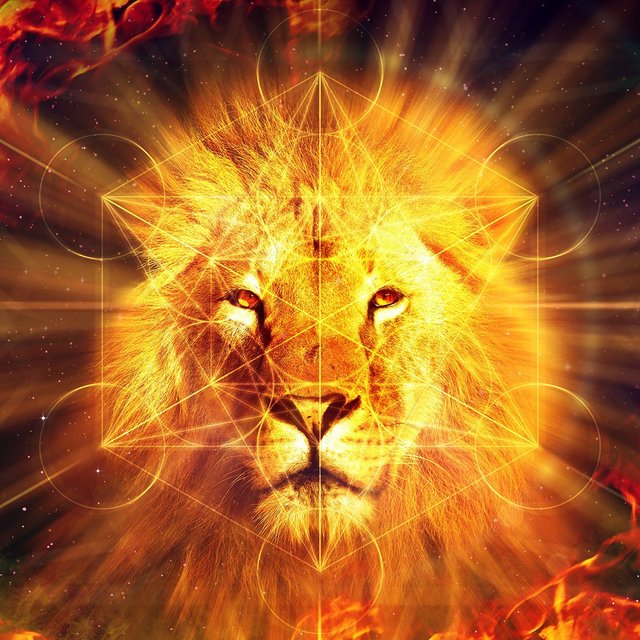
The lion Panthera leo is a species in the cat family Felidae; it is a muscular, deep-chested cat with a short, rounded head, a reduced neck and round ears, and a hairy tuft at the end of its tail. The lion is sexually dimorphic; males are larger than females with a typical weight range of 150 to 250 kg (330 to 550 lb) for the former and 120 to 182 kg (265 to 400 lb) for the latter. Male lions have a prominent mane, which is the most recognizable feature of the species. A lion pride consists of a few adult males, related females and cubs. Groups of female lions typically hunt together, preying mostly on large ungulates. The species is an apex and keystone predator, although they scavenge when opportunities occur. Some lions have been known to hunt humans, although the species typically does not.
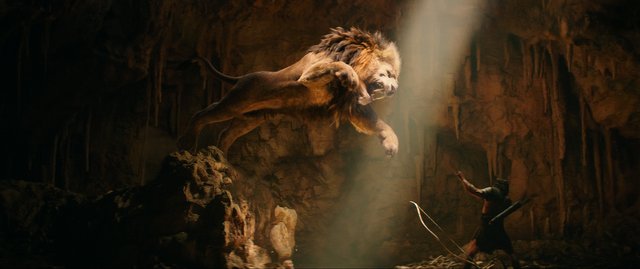
[Greece - Story of the Leo The BEAST]
The Nemean Lion story supposedly connects to the constellation Leo and it's the fifth sign of the zodiac in astrology. It is repeatedly mentioned in different versions of this story that either Zeus or Hera decide at this point to create the Leo constellation. The Leo constellation is connected in almost every way to the sun. In the zodiac, Leo is a fire sign and represents those born in the summer months. In ancient times, the constellation lined up almost perfectly with the summer solstice. Leo's brightest star, Regulus, was often called the "Red Flame" and was thought to contribute to the heat of summer.
Hera has essentially played "Godmother" to most of Greek myth's great monsters, including the Nemean Lion. Leo Nemeaeus was a vicious monster in Greek mythology that lived at Nemea. It was eventually killed by Heracles. It could not be killed with mortals' weapons because its golden fur was impervious to attack. Its claws were sharper than mortals' swords and could cut through any armor. Today, lions are not part of the Greek fauna. The Asiatic lion subspecies formerly ranged in southeastern Europe. According to Herodotus, lion populations were extant in Ancient Greece, until around 100 BC when they became extinct. The lion is usually considered to have been the offspring of Typhon or Orthrus and Echidna; it is also said to have fallen from the moon as the offspring of Zeus and Selene, or alternatively born of the Chimera. The Nemean lion was sent to Nemea in the Peloponnesus to terrorize the city. The first of Heracles' twelve labours, set by King Eurystheus (his cousin) was to slay the Nemean lion.
It was Hera who first begged Gaia and Tartarus to create the god monster Typhon, who happens to be the Nemean Lion's father. Some legends say that Hera or Selene the moon goddess had nursed the Nemean Lion, but regardless of whether or not you take that literally, Hera has connections to the Nemean Lion more so than Zeus. Plus, the Nemean Lion is named as such because Hera, angry at Zeus, sent it to Nemea to live, where there just so happens to be a shrine to Zeus. Thus anyone wanting to worship Zeus would have to get through a gigantic, almost indestructible lion first. It makes sense that Hera, who sent the Lion to Nemea in the first place, took pity on the creature or perhaps felt guilty for it getting hunted down and killed and allowed it to live amongst the stars, next to Selene, the moon goddess, who adored him.
More Greek connections.
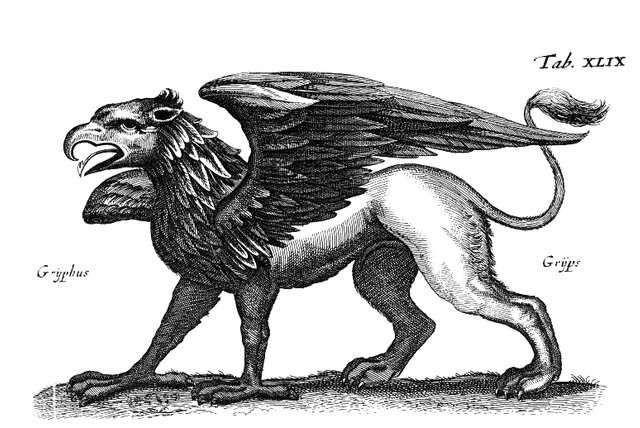
The Griffin is a mythological Greek creature who is known as the protector of treasure. His body is a combination of lion and eagle parts. The Griffin's claws are thought to change in the presence of poison and many drinking vessels were made in his shape for this reason. Griffins were thought to guard the gold mines in India and Scythia. They are also thought to guard the Tree of Life, knowledge and the road to salvation.
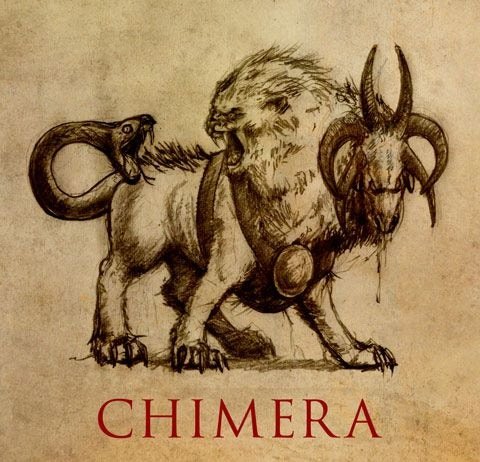
Chimera appears in ancient Greek mythology with the head of a lion, the body of a goat and the tail of a serpent. Both Homer and Hesiod had written about his monster as a fierce, fire breathing creature which terrorizes the land of Lycia. The Chimera is the offspring of Echinda and Typhon and was raised by the King of Caria, Amisodarus.
Chnubis is a Roman god with both Egyptian and Greek properties. He is depicted as a snake with a lion's head. Mahes is also know as the lord of the massacre and is depicted as either a lion or a man with a lion's head. He was the son of Bast. Like other leonine deities, he is fierce and aggressive, but he is also known as the protector of the innocent and as a god of healing. He was worshipped predominantly in the Nile Delta and there is a temple dedicated to him in Bubastis. In Greece he is known a Miysis.
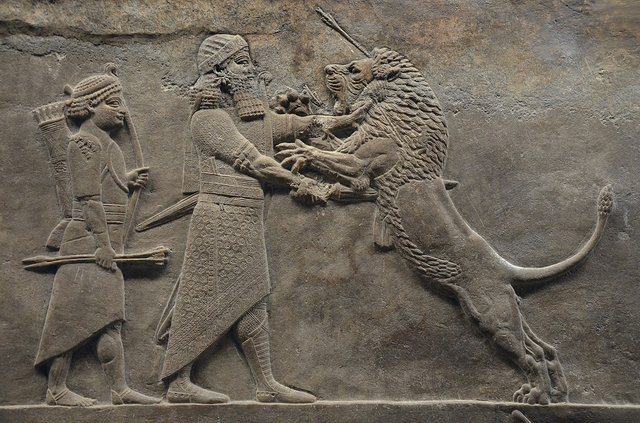
The First Lion- King's Gates [Persia]
The royal Lion Hunt of Ashurbanipal is shown on a famous group of Assyrian palace reliefs from the North Palace of Nineveh that are now displayed in room 10a of the British Museum. They are widely regarded as "the supreme masterpieces of Assyrian art". They show a formalized ritual "hunt" by King Ashurbanipal (reigned 668 – c. 631/627 BC) in an arena, where captured Asian lions were released from cages for the king to slaughter with arrows, spears, or his sword. They were made about 645–635 BC, and originally formed different sequences placed around the palace. They would probably originally have been painted, and formed part of a brightly coloured overall decor.
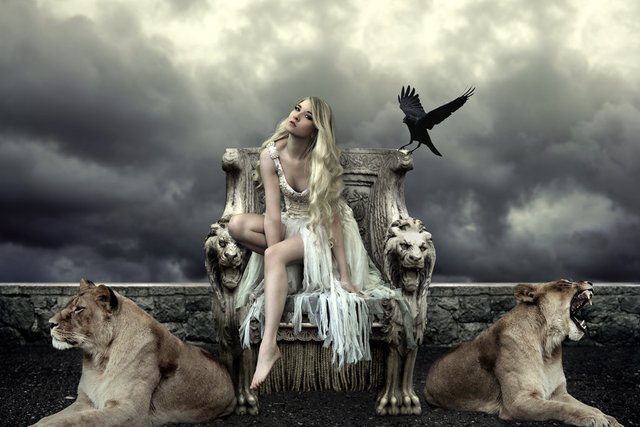
The Babylonian goddess Ishtar [Inanna] associated with love, beauty, sex, desire, fertility, war, justice, and political power. She was originally worshipped in Sumer and was later worshipped by the Akkadians, Babylonians, and Assyrians under the name Ishtar. She was known as the "Queen of Heaven" and was the patron goddess of the Eanna temple at the city of Uruk, which was her main cult center. She was associated with the planet Venus and her most prominent symbols included the lion and the eight-pointed star. has been represented driving a chariot drawn by seven lions. Ishtar's Sumerian analogue Inanna was frequently depicted standing on the backs of two lionesses. Such symbolism was appropriated by Saddam Hussein's regime in Iraq for their Lion of Babylon tank, with the technology adapted from a Russian model. Ancient depictions often described as "panthers" (because of no mane), in fact, are lionesses and may be identified easily by the distinctive tip of their tails that artists familiar with their subject, correctly portrayed.
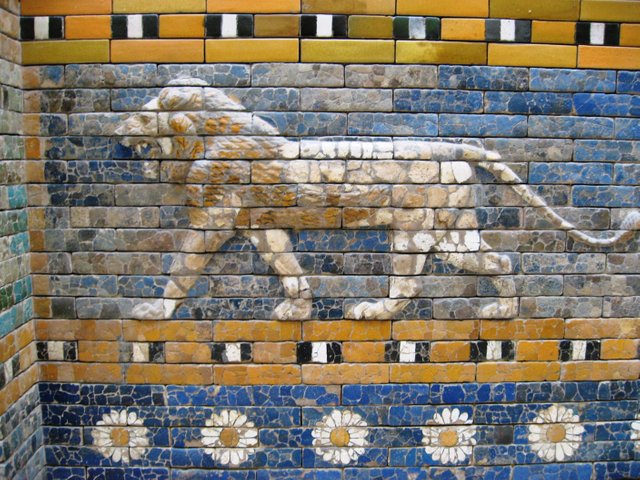
The lion above comes from the Ishtar Gate, the eighth gate to the inner city of Babylon, which was constructed in around 575 BC under the orders of Nebuchadnezzar II.
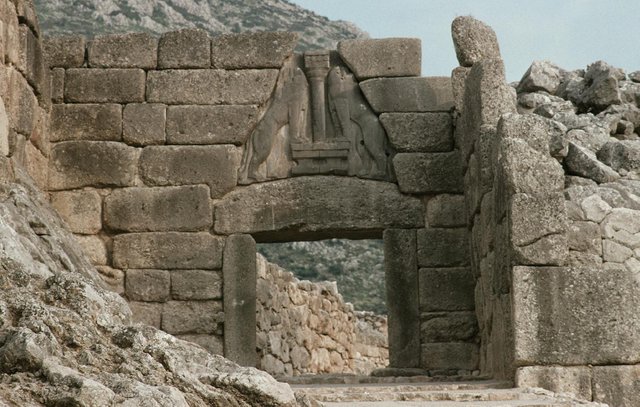
The Lion Gate was the main entrance of the Bronze Age citadel of Mycenae, southern Greece. It was erected during the 13th century BC, around 1250 BC in the northwest side of the acropolis and is named after the relief sculpture of two lionesses or lions in a heraldic pose that stands above the entrance. It is the sole surviving monumental piece of Mycenaean sculpture, as well as the largest sculpture in the prehistoric Aegean. It is the only monument of Bronze Age Greece to bear an iconographic motif that survived without being buried underground, and the only relief image which was described in the literature of classical antiquity, such that it was well known prior to modern archaeology. It is a massive and imposing construction, standing 3.10 m (10 ft) wide and 2.95 m (10 ft) high at the threshold. It narrows as it rises, measuring 2.78 m (9 ft) below the lintel. The opening was closed by a double door mortised to a vertical beam that acted as a pivot around which the door revolved. The gate itself consists of two great monoliths capped with a huge lintel that measures 4.5×2.0×0.8 m (15×7×3 ft). Above the lintel, the masonry courses form a corbelled arch, leaving an opening that lightens the weight carried by the lintel. This relieving triangle is a great limestone slab on which two confronted lionesses or lions carved in high relief stand on either sides of a central pillar.
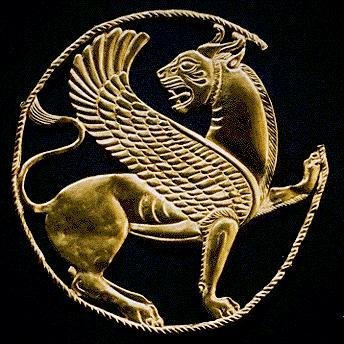
Lion in the Iranian mythology is a symbol of courage and monarchy. He/she is portrayed standing beside the kings in artifacts and sitting on the graves of knights. Imperial seals were also decorated with carved lions. The lion and sun motif is based largely on astronomical configurations, and the ancient zodiacal sign of the sun in the house of Leo. Lion and sun will become a symbol of royalty in Iranian flag and coins. Goddesses Anahita sometimes have portrayed standing on a lion. Lion is also title of the fourth grade of Mithraism.

Imdugud is the thunderbird of the Sumerian god Enki, the patron god of artisans. Imdugud is the bringer of the south wind who carries the rain on his back and his roar is the thunder. He is depicted as a bird with a lion's head.
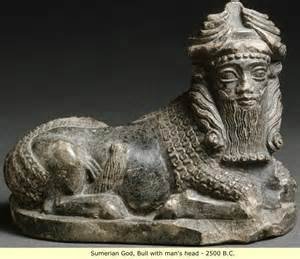
Ningirsu was the god of fertility, rain and irrigation in ancient Sumer and Babylon. There is a temple dedicated to this god in the ancient city of Girsu. He is depicted as an eagle with a lion's head.
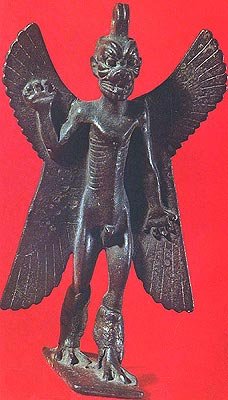
Pazuzu is the ancient Mesopotamian demon who has the wings of an eagle, the tail of a scorpion and the claws of a lion. Pazuzu was known as the "king of the evil wind demons," but he was also often seen on amulets which were used as protection during childbirth.
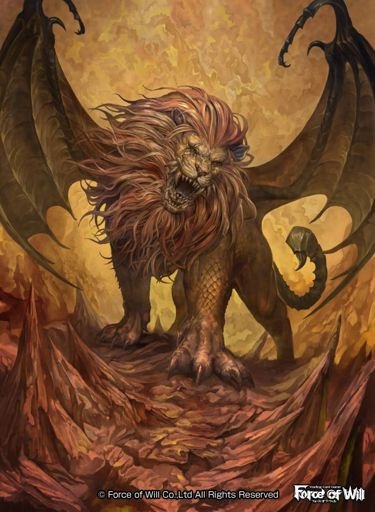
The Manticore has the body of a lion, the head of man with many rows of teeth, a scorpion's tail and a flute-like voice. The Manticore is rumored to live in the forests of India and, like the Sphinx, gives its prey riddles before killing it. It likes the taste of human flesh in particular. The Manticore seems to originate in ancient Persian mythology and became an emblem for the profit Jeremiah in the middle ages. At the same time it became a symbol of tyranny, disagreement and envy.
According to Islamic tradition, God created the lion from the blood of the prophet Noah (or Nuh). While Noah had been nailing the planks of the ark together, Satan came in the shape of a wild boar and dislodged a plank that had been nailed down. Noah hammered it back into place three times, but on the third attempt he hit his thumb in his haste to finish before the rains started, The blood that flowed into the sand was changed into a lion which then chased away the boar.

The Mesopotamian Lion Man is shown as a man above the waist and a lion below. He stands upright and carries a staff. He is called Uridimmus ("Mad Lion'). He may represent the Sumerian god, Utu, or the Akkadian god, Samas, who brings the beneficent light of the sun to Earth. He is the God of truth, justice and rectitude, a destroyer of evil and a protector of kings. As Samas, he enables the king Etana to free an eagle which has been trapped in a pit by the serpent. Samas brings the plant of life to Etana and enables him to fly to heaven on the eagles back.
[Egypt]
The earliest historical records in Egypt present an established religious pantheon that included a lioness as one of the most powerful cultural figures, protecting the people and especially, their rulers, as well as being assigned powerful roles in nature. As human groups moved from being isolated clans and tribes to cities, kingdoms, and countries, ancient symbols retained their importance as they assumed new roles and lions have remained as popular symbols through to modern times.
The earliest tomb paintings in Ancient Egypt, at Nekhen, c. 3500 B.C., classified as Naqada, possibly Gerzeh, culture include images of lions, including an image of a human (or deity) flanked by two lions in an upright posture. Among ancient Egyptians, from prehistoric times through well documented records, the war goddess Sekhmet, a lioness, later depicted as woman with a lioness head, was one of their major deities. She was a sun deity as well as a fierce warrior and protector. Usually she was assigned significant roles in the natural environment.
In Egypt, the lion represented the ferocious heat of the sun and was seen in the likeness of Sekhmet who is the Egyptian goddess known as the Eye of Ra. She is the power that protects the good and annihilates the wicked.
.jpg)
Sekhmet is a very powerful ancient Egyptian goddess of war and vengeance who was married to Ptah. She was worshipped in Memphis and Luxor. Her name means "powerful" and in battles she would breathe fire on the King's enemies. At one point, however, Sekhmet lost the plot and began a systematic slaughter of all humankind. Ra, fearing the death of all of humanity, intoxicated her with a blood colored beer which she believed to be real blood. She awoke slightly hung over but satiated of her need for further destruction.
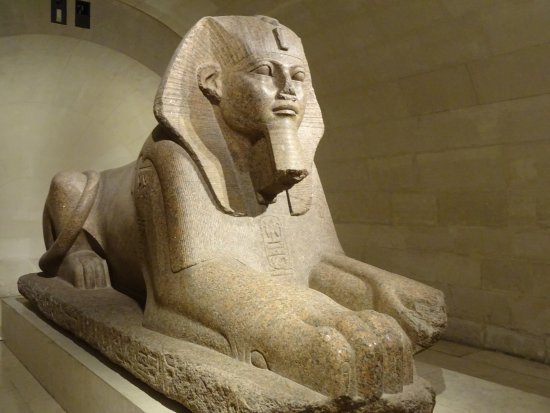
The Sphinx is perhaps the most well know of the leonine creatures. It is found in both ancient Greek and Egyptian mythology and appears in many stories, the most famous being Oedipus Rex. The Sphinx is a combination of a lion's body with the head of a man. In Greek legend, the sphinx also has wings. The word sphinx comes from the Greek sphingo which means to strangle. Sphinxs guarded tombs and treasure and symbolizes abundance, power, wisdom, riddles, truth and secrets.
Dedun is an Egyptian/Nubian god of wealth and incense. Sometimes depicted as a lion, but more often as a human.
Arensnuphis the anthropomorphic Egyptian god is sometimes depicted as a lion, at other times as a man with a plumed crown. He is often referred to as a companion of Isis and there is a temple dedicated to him in Philae built during the reign of Ptolemy IV Philopator. Other names include: Ari-hes-nefer, Arsnuphis and Harensnuphis.
Menhit Another ancient Egyptian deity, Menhit means "she who slaughters". Menhit is the wife of Chnum and together they had a son named Hike. The threesome were worshipped as a trinity in the city of Latopolis. They were called the Esna Triad. Like other gods of war, Menhit was thought to ride ahead of the army, slaughtering enemies.
Aker is one of the oldest Egyptian lion gods. He guarded the gate of the dawn through which the sun god emerged everyday. He is also thought to cure snake bites and he opened the doors to the underworld for deceased pharaohs.
[Christian / Pre-Christian]
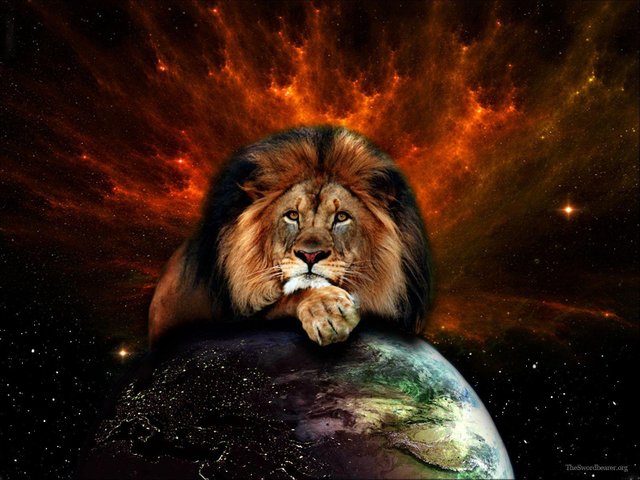
Several Biblical accounts document the presence of lions, and cultural perception of them in ancient Israel. The best known Biblical account featuring lions comes from the Book of Daniel (chapter 6), where Daniel is thrown into a den of lions and miraculously survives. A lesser known Biblical account features Samson who kills a lion with his bare hands, later sees bees nesting in its carcass, and poses a riddle based on this unusual incident to test the faithfulness of his fiancée (Judges 14). The prophet Amos said (Amos, 3, 8): "The lion hath roared, who will not fear? the Lord GOD hath spoken, who can but prophesy?", i.e., when the gift of prophecy comes upon a person, he has no choice but to speak out. In 1 Peter 5:8, the Devil is compared to a roaring lion "seeking someone to devour."
In gnostic traditions, the Demiurge is depicted as a lion-faced figure ("leontoeides"). The gnostic concept of the Demiurge is usually that of a malevolent, petty creator of the physical realm, a false deity responsible for human misery and the gross matter than traps the spiritual essence of the soul, and thus an "animal-like" nature. As a lion-headed figure, the Demiurge is associated with devouring flames, destroying the souls of humans after they die, as well as with arrogance and callousness.
A lion-faced figurine is usually associated with the Mithraic mysteries. Without any known parallel in classical, Egyptian, or middle-eastern art, what this figure is meant to represent currently is unknown. Some have interpreted it to be a representation of Ahriman, of the aforementioned gnostic Demiurge, or of some similar malevolent, tyrannical entity, but it has also been interpreted as some sort of time or season deity, or even a more positive symbol of enlightenment and spiritual transcendence.
The lion is one of the Hayoth (Tetramorphs), being the symbol of St. Mark. This emblem of the lion is the guardian beast of the city of Venice, which is under the patronage of St. Mark. Christ's resurrection was often represented by a lion because of the belief that male lions breathed life into their cubs, causing them to come alive after they had been born.
There is also connection with Jesus as the Sun and Lion as well as the Lion of Judah.
[Eastern]
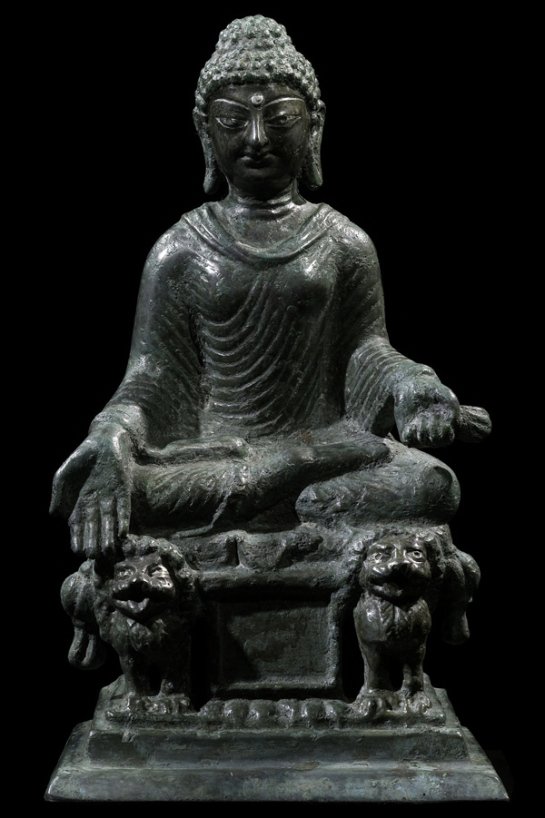
Buddha Gautama would refer to himself, he chose to be represented as the stately lion. To describe his proclamation of the Dharma - valiant and thunderous - as is expressed through a veritable lion's roar in the spiritual domain.
Goddess Durga is the mother of the universe and believed to be the power behind the work of creation, preservation, and destruction of the world. Since time immemorial she has been worshipped as the supreme power of the Supreme Being and has been mentioned in many scriptures - Yajur Veda, Vajasaneyi Samhita and Taittareya Brahman. The Meaning of "Durga"
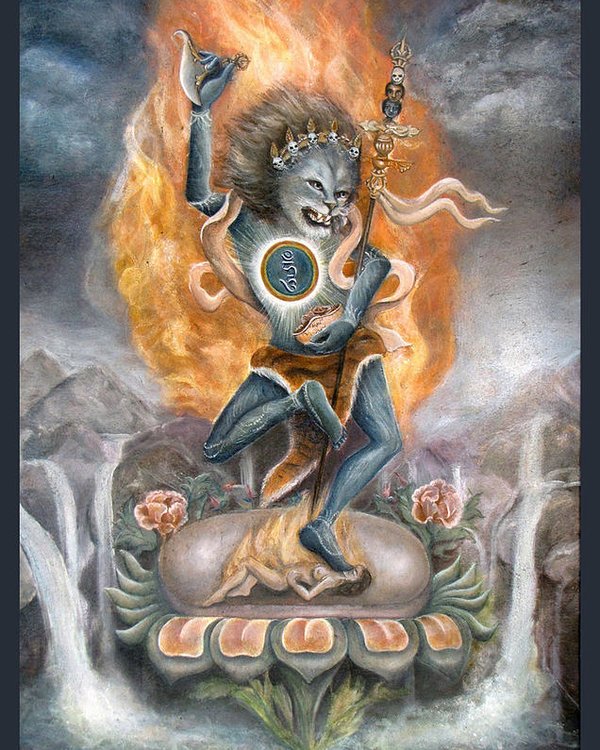
Simhamukha, or Senge Dongma, can be translated into English as Lion-Faced Dakini.
This dakini and female tantric Buddha is regarded as one of the principal fierce manifestations of Padmasambhava, the 8th Century mahasiddha who was a founder of the Nyingma or 'Ancient School' of Tibetan Buddhism. As such, she is connected with many ceremonies of the Dzogchen tradition. A fierce dakini, she is also one of the Phramenma, a group of female deities from the Bardo Thödol, or 'Tibetan Book of the Dead'. When fully appreciating the benefits of this wrathful wisdom deity (according to the Nyingma tradition), she is the principal Dakini teacher of Padmasambhava.
Narasingha, the man-lion, is the fourth incarnation of Vishnu. Yali is a mythical Indian creature with the body of a lion and the head of an elephant.
In Thaliand, the oldest royal family traces its descent from the lion who elopes with the kings daughter and persuades her to live with him in the wilderness, where she gives birth to a human son called Singh (Lion). Singh comes to court and when he returns home while on a lion hunt, he recognizes his father and refuses to kill him. The princess's mother reveals Singh's identity to those at court, whereupon he ascends to the throne of his grandfather.
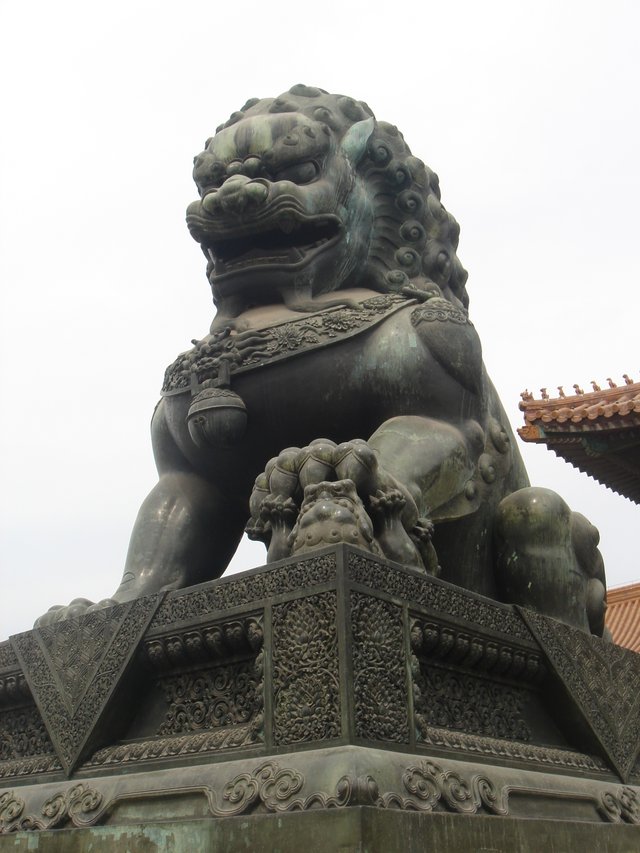
[Oriental]
Imperial Guardian ( Pinyin: Shíshī - Stone Lion) are also called Fu Lion, Foo Lion or Fu dog.
An Imperial Guardian Lion is supposed to have mystic protective powers and can be found in front of such places as temples, imperial palaces, government offices or traditionally in front of homes of high ranking members of society indicating their financial and/ or social status.
[African]
In Africa, the lion is revered as a god and, like in the Thai story, is believed to be the founder of many dynasties. Magical lion forebears taught the arts of hunting, bush-lore and the spell craft that brings game to their human descendents. In Sudan, there are stories of women who are the offspring of lions and humans, but they can be easily discerned for they will eat only meat no grains or vegetables and it is good to notice this before you marry one, unless you wish to become the next meal.
[Native American]
As far as lion symbolism goes in Native American culture, the Hopis achieved a classic statement of reverence for nature and "The mountain lion," said Leigh Jenkins, the Hopi cultural preservation officer, "is very sacred to the Hopi. He is a deity, a guardian of the tribe, to whom Hopis look for guidance during certain ceremonies. He is regarded as the strongest and most fearless animal and the greatest of hunters. His name, Oha, also refers to the black clays used to decorate particular kinds of prayer sticks. Black represents strength in delivering the prayer sock's message to the homes of the rain gods."

[Renaissance]
In the 14th-century Byzantine poem, An Entertaining Tale of Quadrupeds—a dialogue between various animals—the terms “pards,” “cat-pards,” and “leopards” are all thrown around with relative abandon. The leopard is told he is a “beast that’s born in sin and brought up out of wedlock,” whose lioness mother has washed the scent of her pard lover from him. If the lion smells it, the writer suggests, he will kill her and never mate with a lioness again.
The leopard, the offspring of a lion and a “pard.” We know now that leopards are, in fact, their own thing: the offspring of a mommy leopard and a daddy leopard. But for a long time, leopards were believed to be the sterile, degenerate spawn of a lioness and a male pard. The pard was a terrifying semi-mythological big cat with a lust for blood.

[Popular Culture]
The Lion King, was a remake of a very old tale, perhaps one of the oldest tales on this planet. Osiris and Isis were the earlier incarnations of Mufasa and his lioness wife, Sarabi. Unfortunately, just like Mufasa, Osiris also has a jealous brother named Set. Set tricks Osiris by creating a beautiful wooden chest and convincing him to lie in it by creating a contest whereby the person who fits in the wooden chest wins it. Of course, like Cinderella’s slipper, the chest fit Osiris perfectly. Once Osiris was in the chest (or coffin), the lid was shut; and Osiris was tossed into the Nile river to die. Later, when Isis finds her dear husband, Set enters the scene again and cuts Osiris into 14 pieces. Isis must put Osiris back together and breath life back into him in order to create a son. That son is Horus.
[Symbols]
Lions as dream symbols indicate we may feel as though we are being preyed upon, or we are in a position to defend ourselves. Dreaming of lions may also be a sign of our need to get in touch with our emotions, and tame them if necessary. In esoteric studies, the lion makes its appearance in the Tarot where it is illustrated in the Strength card of the Major Arcana. Symbolic attributes of the lion include Courage, Power, Royalty, Dignity, Authority, Dominion, Justice, Wisdom, Ferocity. In alchemy, the symbolic meaning of lions is associated with the highly idealistic and prized attributes of gold.
[CUBE MYTHOLOGY]
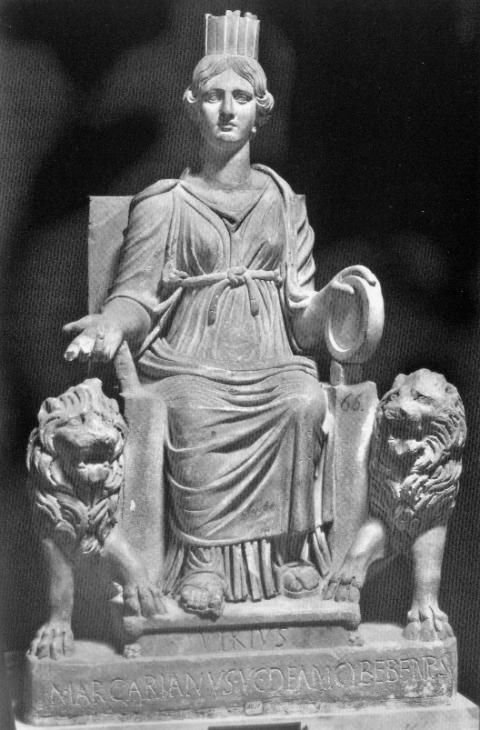
KYBELE (Cybele) was the ancient Phrygian Mother of the Gods, a primal nature goddess worshipped with orgiastic rites in the mountains of central and western Anatolia. The Greeks identified her with their own mother of the gods--the Titaness Rhea. Kybele was the daughter of the Phrygian sky-god and earth-mother. She was born as an hermaphrodite named Agdistis who was castrated by the gods to become the goddess Kybele. The Phrygian sky-god is identified with the Greek Zeus in Pausanias' account of the myth. The highest ideal of Rhea in works of art was produced by Pheidias; she was seldom represented in a standing posture, but generally seated on a throne, adorned with the mural crown, from which a veil hangs down. Lions usually appear crouching on the right and left of her throne, and sometimes she is seen riding in a chariot drawn by lions. The various names by which we find Rhea designated, are, "the great mother," "the mother of the gods,"Cybele, Cybebe, Agdistis, Berecyntia, Brimo, Dindymene, "the great Idaean mother of the gods." Her children by Cronos are enumerated by Hesiod : under the name of Cybele she is also called the mother of Alce, of the Phrygian king Midas, and of Nicaea. Stories in which Kybele's is conflated with the Greek Rhea. Kybele was the mother of the Phrygian god Sabazios--who the Greeks identified with Dionysos. As the Greek god had a different genealogy, the Phrygian myths were adapted to describe Mother Rhea as his nurse and mentor. The Orgiastic Cult (Orgia) of Dionysos-Sabazios was derived from that of Kybele.
[Story of Attis- connection to Jesus?]
Phrygian legend about him Attis being this. Zeus let fall in his sleep seed upon the ground, which in course of time sent up a Daimon, with two sexual organs, male and female. They call the daimon Agdistis. But the gods, fearing Agdistis, cut off the male organ. There grew up from it an almond-tree with its fruit ripe, and a daughter of the river Saggarios (Sangarius), they say, took the fruit and laid it in her bosom, when it at once disappeared, but she was with child. A boy was born, and exposed, but wastended by a he-goat. As he grew up his beauty was more than human, and Agdistis [Kybele] fell in love with him. When he had grown up, Attis was sent by his relatives to Pessinos, that he might wed the king's daughter. The marriage-song was being sung, when Agdistis appeared, and Attis went mad and cut off his genitals, as also did he who was giving him his daughter in marriage. But Agdistis repented of what she had done to Attis, and persuaded Zeus to grant the body of Attis should neither rot at all nor decay. These are the most popular forms of the legend of Attis. Since then, a yearly ritual has been performed to purify the body of the dead Attis. The priests—referred to as Galli or Galilee—are emasculated in emulation of Attis. A pine tree is chopped down, covered with violets and carried to the shrine of Cybele on Mt. Dindymus. There Attis is mourned for 3 days. Then, when Cybele brings him back to life, there is a wild and joyful celebration.
Rhea is a character in Greek mythology, the Titaness daughter of the earth goddess Gaia and the sky god Uranus as well as sister and wife to Cronus. In early traditions, she is known as "the mother of gods" and therefore is strongly associated with Gaia and Cybele, who have similar functions. The classical Greeks saw her as the mother of the Olympian gods and goddesses, but not as an Olympian goddess in her own right. The Romans identified her with Magna Mater (their form of Cybele), and the Goddess Ops.
[SPIRIT Mythology]
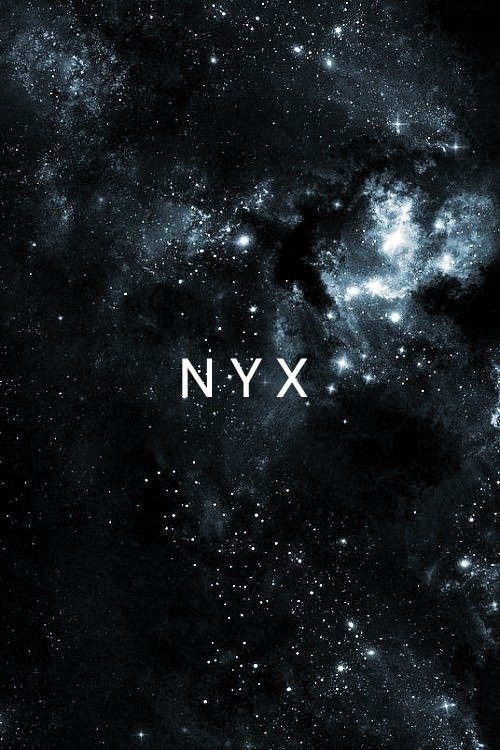
Nyx is the Greek goddess or personification of the night. A shadowy figure, Nyx stood at or near the beginning of creation and mothered other personified deities such as Hypnos Sleep and Thanatos Death, with Erebus Darkness. Her appearances are sparse in surviving mythology, but reveal her as a figure of such exceptional power and beauty that she is feared by Zeus himself.
So where did Spirit originate before that?
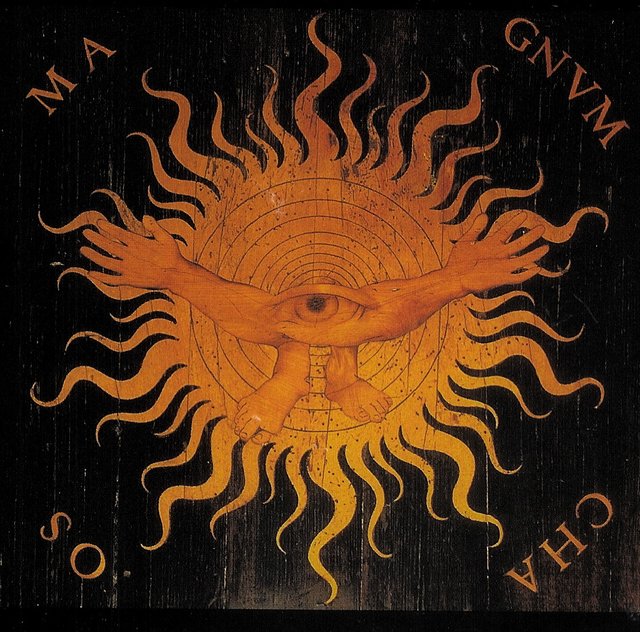
Nyx came from Chaos. Chaos refers to the void state preceding the creation of the universe or cosmos in the Greek creation myths, or to the initial "gap" created by the original separation of heaven and earth. In Hesiod's Theogony (c. 700 BC), Chaos was the first of the primordial deities, followed by Gaia (Earth), Tartarus (the nether abyss), and Eros (Love). From Chaos came Erebus (Darkness) and Nyx (Night). Christianized Chaos is equal to Archangel Michael.
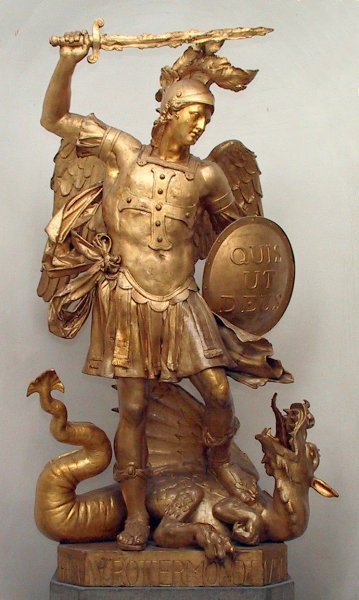
CONCLUSION:

If you can root the Word Cube back to origins you would come across Kybele and even Cybernetics. She's truly the Mother of the MATRIX because she made Attis which is like Jesus and died and rose after 3 days. It was stated once that "Spirit" is really "Lioncubes" Great Great Grandmother. How would that work exactly? Tracing back Kybele's ancestry we do indeed lead to Nyx. Then we can say in a sense that she came from "Chaos" which is much like Archangel Michael which is another name for Jesus also connected to the Lion and also the Demiurge. So the Cube would be like Mother Mary to [Lion] Jesus .
You'll do all that- but you wont say LION = J and CUBE = J and SPIRIT = J. You are the funniest troll in the world hands down.
So you can Decode J-CUBE. Alright then you got me! LMFAO

Kitty Robot Go Go Go.